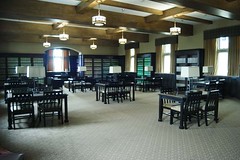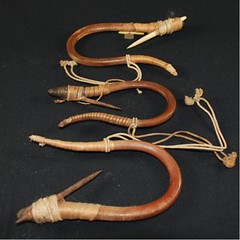The title of this entry may seem a little odd to people who are familiar with the collections, that we don’t actually have an Indian Museum collection. And of course, they’d be correct. In 1929, however, things were different.
The earliest mention that I have found so far of the “Indian Museum” was in the American Indian magazine, November 1929 issue. There was a plan to house such a museum in the new McFarlin library, and proposed that a large scale museum would later be built elsewhere on campus. The articles indicated a strong need for such a museum, since Tulsa was not only the “Oil Capital of the World”, but was also, in fact, the Native American capital of the world. It should be noted that this predates the existence of the Thomas Gilcrease Museum and Philbrook Museum, and was contemporaneous with the earliest “airplane museum” phase of the Woolaroc Museum. Even earlier, in 1915, Charles Morrisett, an instructor at Henry Kendall College which preceded The University of Tulsa had lent his Indian pottery collection to the college in an attempt to start a museum. That earlier attempt fell through, although his collection would later join the others in the Indian Museum.
A museum space was set aside in the library building that broke ground in June 1929, and was completed a year later. That space was in what is now the Student Study (3rd floor, north wing). Collections were gathered. The principle collections were the Ellis Clark Soper Collection, the Alice Robertson Artifacts, the Bright Roddy collection, and the James Wolfe collection of Borneo artifacts. The Pennet pictures depicting Mexican life were lent by Sinclair Petroleum Corp. These collections held materials from Native American tribes as diverse as the Caddo, Choctaw, Tsalagi (Cherokee), Kansa (Kaw), Osage, Chaticks-si-Chaticks (Pawnee), Muskogee (Creek), Diné (Navajo), Oglala Lakota, Piikáni (Blackfeet), Nimíipuu (Nez Perce), Otoe, and Kaui-gu (Kiowa).
Included in the collection were pots, baskets, clothing, bundles, blankets, feathered head dresses, pipes, bags, pouches, clothing, moccasins, boots, saddles, bows, Civil war era materials, firearms, and so on.
The Museum opened in June 1931, after the collection had been organized by Eva Horner, a trained anthropologist. There were two “See the Museum” events, one in December 1931, and one in April 1933. Unfortunately interest soon waned, and with that the hours of operation declined from 9-11 am Monday through Friday so that by November 1934, the museum was open by appointment only.
In 1937, the museum was closed, and the materials placed in storage. By 1940, the collections had been sent elsewhere. Bright Roddy and Robertson were lent to the new Philbrook museum, along with the Native American portions of the Soper Collection. It may be presumed that the borrowed collections were returned to their lawful owners. The remaining materials were lost to folklore and oblivion.
Interestingly, as this dispersal was occurring, we continued to acquire. For example, the Spiro Mounds materials, currently on permanent loan to the Gilcrease Museum were acquired in 1938, and the Buell-Thawley glassware collection were acquired sometime between 1948 and 1961 (the former date being when William Thawley died, and the latter, the date the collection established to honor him was lent to Philbrook, where it remained on display for many years). In the 1970s, we acquired four separate pottery collections, mostly pre-Columbian Mississippian, and some ancient Mexican pieces. In the late 70s, we were given a small array of artifacts from the estate of John W. Shleppey, along with an immense library of Native American and Americana materials. The Steiner-Isaacs recordings of Ponca Songs were received in the late 1970s; and the F. Morris Lookout recordings in about 2001.
In 1995, the remaining Native American Soper collection and the Bright Roddy collection were deeded to Philbrook.
Currently, from the original museum collections, Special Collections still holds some fragments of the Soper Collection, including the photographs and the lithographs, and bits of Robertson’s artifacts. Also with the Soper Collection remain a wide field of mysteries, such as the disposition of the bulk of the collection, which may or may not have included the majority of the Soper-Savage “pre-Columbian” copper plates, eventually procured by the Church of Jesus Christ and the Latter Day Saints in the 1960s, and eventually were transferred to the Michigan Historical Museum in Lansing. Were they ever in Tulsa? They are on my original inventory.
In the end, we are reminded of the pitfalls of trying to be all things to all people, and of the need to maintain better documentation for the people doing our jobs in the future.
By the way, this week marks the 79th anniversary of the first “Visit the Museum” event.


